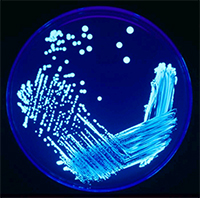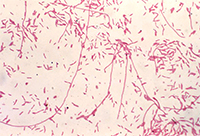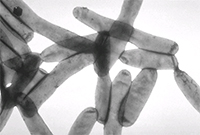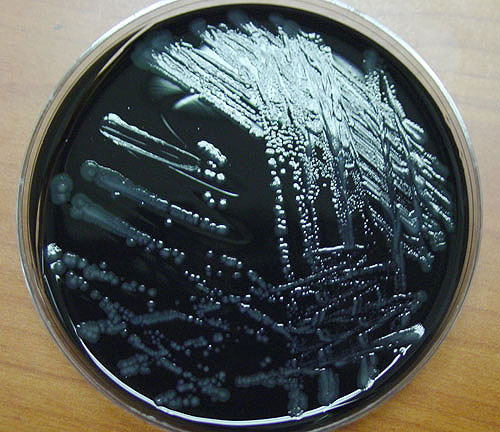- Laboratory Services
- Mold Services: Air
- Mold Services: Surface
- Bacteria Services: Air
- Bacteria Services: Surface
- Asbestos Services
- USP Services
- PCR Services
- Allergen ELISA Services
- Other Lab Services
- USP 797 Testing
- Legionella Water Testing
- ERMI Testing
- Materials Testing
- Additional Services
- Webinars: IAQ Training Courses
- Mobile App for iPhone & Android
- BioCassette
- EMLab P&K Pocket Guide
- Technical Papers
- MicroLabs
- MoldRANGE™ Report
- MoldRANGE™ California Climate Report
- MoldRANGE™ Local Climate Report
- MoldRANGE™ CFA Report
- MoldSCORE™ Report
- Risk Assessment Training Courses
- Quality Assurance
- Quality Assurance
- New User Introduction
- Become A Client
- Additional Information
- New Client Forms (pdf)
- Chain of Custody (pdf)
|
|
Legionella Lab Services for Legionella Water Testing in Cooling Towers and Water Systems
Is Legionella Water Testing Important?
Outbreaks of Legionnaires' disease receive significant media attention especially when
a large number of people become ill or die. In contrast to highly publicized outbreaks,
single infections with Legionella bacteria often go unnoticed. According to the
Centers for Disease Control and Prevention (CDC), between 8,000 and 18,000 people are
hospitalized with Legionnaires' disease in the United States each year. Legionnaires'
disease is a legitimate public health concern as its fatality rate during an outbreak
ranges from 5% to 30% in those who contract the disease. The immediate consequences for
the building owner or manager faced with liability claims and negative publicity can be
devastating and extremely costly. Many experts agree that proactively managing the
risk of Legionella bacteria in cooling towers and water systems is more cost
effective than responding to an outbreak retroactively.
While a few states and municipalities have instituted guidelines for monitoring
Legionella, there are no federal or state regulations that require routine
monitoring of buildings with susceptible individuals. We recommend building owners and
hospitals establish a Legionella control and management program, including
routine monitoring and testing, in areas where the risk of Legionella infection
is high. This accomplishes two tasks:
1) It indicates the effectiveness of control measures already in place, and
2) It provides an early warning of potential problems.
Legionella in Cooling Towers and Water Systems
Although some species of Legionella can be found in the soil, most species live
in water. The Gram-negative Legionella bacterium thrives in warm, stagnant water
but it can survive under a wide range of temperatures (68° to 122°F), pH and
dissolved oxygen levels. Legionella pneumophila has been isolated and associated
with outbreaks stemming from air-conditioning cooling towers, whirlpool spas and showers.
Other water devices can include potable water systems, whirlpool baths, respiratory care
equipment, humidifiers and faucets. As water from these sources is aerosolized,
individuals inhale the Legionella-containing droplets and the organism is
aspirated into the lungs. Smokers and individuals with weakened immune systems have a
higher risk of developing Legionellosis (Legionnaires' disease or Pontiac fever).
Lab Services: Legionella Detection Methods
Legionella Culture Method
The culture method remains the "gold standard" for detecting Legionella
from environmental sources. This technique, unfortunately, requires up to 10 days to
complete, precious time that could be used to pinpoint Legionella sources and
prevent additional exposures.
Legionella PCR Method
Another Legionella detection method is polymerase chain reaction (PCR), a molecular
technique that offers a very sensitive method and only requires a few hours to complete.
The PCR method provides an extremely powerful screening tool for the rapid Legionella
detection in environmental samples, although it doesn't distinguish between living and dead
cells. But unless the environment has been recently altered, such as with a biocide
application, moderate to high populations of Legionella detected by PCR are usually
indicative of an existing or potential future problem. Therefore, the PCR method can rapidly
identify potential sources, facilitating disinfection processes and help to prevent further
exposures. Because this method does not determine viability of the Legionella
bacteria, the PCR screen must be considered presumptive and requires confirmation via
conventional culture techniques.
Sampling Methods: Swab and Bottle
Swab Sampling
Collect a surface sample with a sterile swab where there is scale build up or on water
outlets. Swabs of faucet aerators and shower heads should be taken before the water
sample from these sites with the aerator or shower head removed if possible. Pre-wet the
swab with water from the sampling site and submerge swab in 3-5 ml of water taken at the
same time to prevent drying during transport. For more information refer to
OSHA's Water Sampling Protocol.
Bottle Sampling
Equipment Needed for Legionella Water Sampling
Sterile bottle with Sodium Thiosulfate preservative
Gloves
Respirator (Wear appropriate respiratory protection during the examination of
water systems if a significant potential exists for exposure to high concentrations
of contaminated aerosols)
How To Sample for Legionella in Water
- Wear gloves and, if necessary, respiratory protection.
- Use sample bottles provided by the analytical laboratory that contain a
sufficient type and amount of neutralizer for any disinfectant agent in the
water system.
- Collect a "pre-flush" sample of the first water drawn from bottom
drains and outlet valves of storage tanks, sumps, and water heaters as well as
faucets and showerheads.
- Allow the water to run until the temperature stabilizes and collect a second
"post-flush" sample when the water temperature is constant.
- Do not overfill sampling bottle because it will rinse out neutralizer.
- Replace cap.
- Label sample container appropriately.
- Ship samples on ice to the Legionella testing laboratory.
Note: Refer to OSHA's Water Sampling Protocol
for detailed instructions.
Quality Control for Legionella Water Testing
The number and types of sites that should be tested must be determined on a case-by-case basis.
Due to the diversity of plumbing and mechanical systems in buildings, you may need more than
one sample from the suspect source. Generally, any water source that may be aerosolized should
be considered a potential means for the transmission of the Legionella bacteria.
Trusted Lab Analysis for Your Legionella Testing
Are you involved with Legionella monitoring programs or Legionella outbreak
control?
|

Legionella sp. colonies cultivated on an agar cultured plate and
illuminated using ultraviolet light.
Copyright © Centers for Disease Control

Gram-stained micrograph of Legionella pneumophila bacteria from
a victim of the 1976 Legionnaires' disease outbreak in Philadelphia.
Copyright © Centers for Disease Control

Transmission electron micrograph of Legionella pneumophila.
Copyright © Centers for Disease Control

Legionella on BCYE agar plate.
Copyright © EMLab P&K
|



